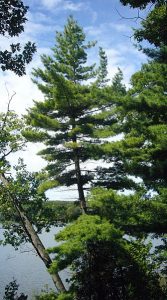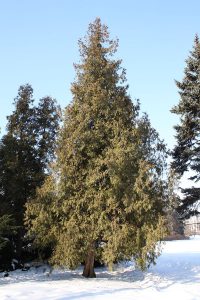By Jack MacRae
 December seems like an appropriate time to talk about evergreens. You see them growing on most landscaped properties in the region! Not only are these trees everywhere, this is the month when pines, firs, cedars, and spruce are bedecked as Christmas trees and wreaths. In spite of their ubiquitous nature and celebratory trappings of ancient spirituality, every single one of these conifers is the result of human planting. None occur naturally. None – that is – except for a few tiny, solitary stands of pine and cedars found growing in the bluffs of the lower Fox River Valley. This article is a toast to those local rarities.
December seems like an appropriate time to talk about evergreens. You see them growing on most landscaped properties in the region! Not only are these trees everywhere, this is the month when pines, firs, cedars, and spruce are bedecked as Christmas trees and wreaths. In spite of their ubiquitous nature and celebratory trappings of ancient spirituality, every single one of these conifers is the result of human planting. None occur naturally. None – that is – except for a few tiny, solitary stands of pine and cedars found growing in the bluffs of the lower Fox River Valley. This article is a toast to those local rarities.
What’s Red or White and Evergreen?

Both white pines (Pinus strobes) and red pines (Pinus resinosa) are towering, stately trees that thrive in the cool air and moist, loose soil of the northeast United States. Under favorable conditions, they are tall, conical trees that can reach 100’ or more in height. They dominate the boreal woods of the north. They provide habitat for many hundreds of species up, down, and across the food chains.
In pre-settlement times, red and white pines made up a large portion of the vast coniferous forests that encircled all five Great Lakes. But in northern Illinois, and away from the sandy soils of Lake Michigan, white pines were scattered. The glaciers deposited too much clay for their liking. Red pines were even less common.
Pining Away

Today the white and red pines found growing precariously atop the sandstone bluffs in LaSalle County represent the extreme southwest edge of their natural range. This small population is isolated from the contiguous pine forests of northern Wisconsin and Minnesota by several hundred miles.
A third Illinois threatened evergreen found in the Lower Fox Valley is white cedar Thuja occidentalis. Like our 2 native pines, the northern white cedar trees in the Fox Valley are relics from a time long ago. Northern white cedars are among the oldest trees east of the Mississippi River; some are believed to be over 1500 years old! One fine senior specimen found near Wedron grew to be 50 feet tall and had a 6’ circumference.
By 1890, an estimated 99% of our native white pines that once grew adjacent to Lake Michigan had been harvested for ship’s masts, and to build houses, stores, and banks. Yet now, ironically, there are many more white pines growing in our parks and backyards than in earlier times. There are also 100% more Colorado blue spruce, Japanese Yew, and giant arborvitaes, for that matter. Evergreens have become common elements in our oak and maple world. This December however, there are 99% more pine trees in living rooms in than in July (I made that last one up) because pines like to party!

